The Gupta Period: Trade, Art & Culture, Economic Development | History for UPSC CSE PDF Download
The Gupta Period
The Gupta period in Indian history is termed as the Golden Age of India. During the Gupta dynasty, industry and trade were generally prosperous.
- The Gupta Empire was a ancient Indian empire from the early fourth century CE to the late sixth century CE. The Indian subcontinent was mostly covered during its height, between 319 and 467 CE.
- Founded by Sri Gupta, it extends through the reigns of Chandragupta I, Samudragupta, Chandragupta II, Vikramaditya, Kumaragupta, and Skandagupta. The Gupta dynasty continued its existence after the death of Skandagupta.
- During this period of peace and stability, both internal and external trade flourished. The decline of Roman trade marked significant shifts in global trade patterns.
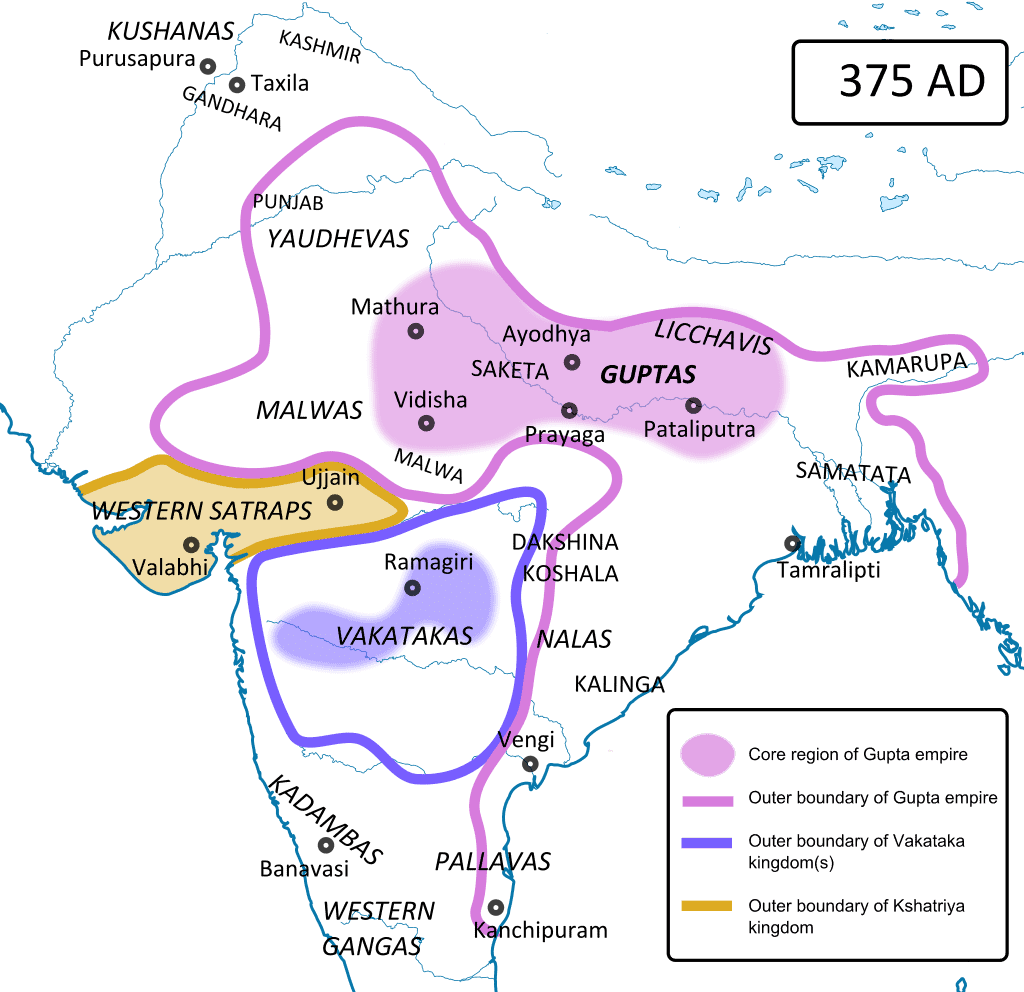
- Fa-Hien, a traveler from China, provided valuable insights into the economic life during the Gupta period. His travels took him through various regions of the empire, where he observed the prosperity and wealth of the people.
- Fa-Hien noted that Magadha, a region within the Gupta Empire was full of cities and its rich people supported Buddhism and gave charities.
Trade and Agriculture - Background
In ancient India, the Gupta dynasty issued the largest number of gold coins which were called dinars in their inscriptions. Regular in size and weight, they appear in many types and subtypes.
- They portray Gupta kings, indicating the latter's love for war and art. Although in gold content these coins are not as pure as Kushan ones.
- They not only served to pay the officers in the army and administration but also to meet the needs of the sale and purchase of land.
- After the conquest of Gujarat, the Guptas issued a good number of silver coins mainly for local exchange, in which silver occupied an important position under the Western Kshatrapas.
- In contrast to those of the Kushans, the Gupta copper coins are very few. This would suggest that the use of money did not touch the common people so much as it did under the Kushans.
 Coins of the Gupta Period
Coins of the Gupta Period - Compared to the earlier period we notice a decline in long-distance trade. Till 550AD India carried on some trade with the eastern Roman Empire to which it exported silk.
- Around AD 550 the people of the Eastern Roman Empire learned from the Chinese the art of growing silk, which adversely affected the export of India. Even before the middle of the 6th century, the demand for Indian silk abroad had slackened.
- In the middle of the 5th century, a guide of silk weavers left their original home in western India in the country of Lata in Gujarat and migrated to Mundus Mandasor, where they gave up their original occupation and took to other professions.
- The striking development of the Gupta period, especially in Madhya Pradesh, was the emergence of priestly landlords at the cost of local peasants. Land grants made to the priest certainly bought many virgin areas under cultivation.
- But these beneficiaries were imposed from above on the local tribal peasants, who were reduced to a lower status. In central and western India the peasants were also subjected to forced labor.
- On the other hand, a good deal of virgin land was brought under cultivation and better knowledge of agriculture seems to have been introduced by the Brahmana beneficiaries in the tribal area of central India.
Trade & Commerce during The Gupta Period
Both internal and foreign trade flourished during this period. Trade was carried on both by land and sea. The main articles of internal trade were cloth, food grains, spices, salt, bullion, and precious stones.
- The trade was carried on by roads and through rivers. Important cities and ports of the Gupta period were Broach, Ujjayini, Visa, Prayag, Banaras, Gaya, Pataliputra, Vaishali, Tamralipti, Kausambhi, Mathura, Peshawar, etc which were well connected by public highways and the state arranged all facilities and security for the travellers and traders.
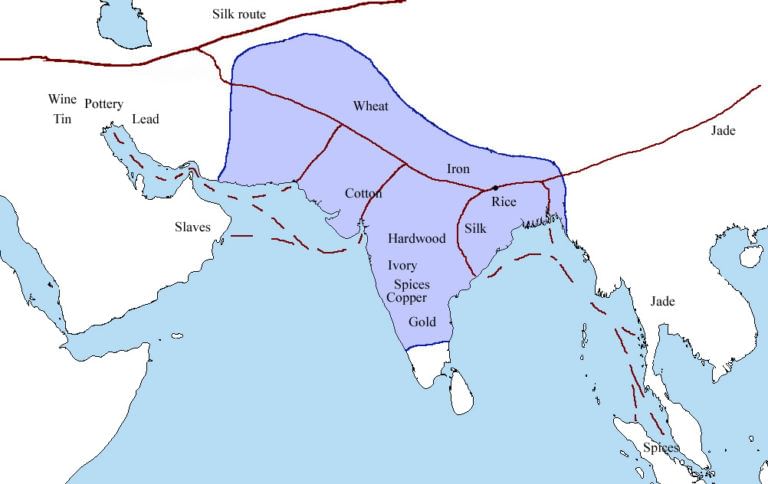 Gupta Empire Trade
Gupta Empire Trade
- Rich riverine traffic was carried along the Ganges, Brahmaputra, Narmada, Godavari, Krishna, and Kaveri. Tamralipti, Kavripatnam, Kalyan, Broach, and Cambay were the principal ports of South, Deccan, and Gujarat.
- A brisk trade was carried on with countries of Southeast Asia, China, and Rome in the west. India exported pearls, precious stones, cloth, perfumes, spices, indigo, drugs, coconuts, and ivory articles while its main items of import were gold, silver, tin, lead, silk, and horses.
- As trade and industry developed, there were many economic activities within the Gupta empire. The traders and merchants played a huge role in the economy of the country.
- The sources of Gupta’s period mentioned the existence of guilds. A guild is a community of traders, merchants, workers, and artisans. Each guild has its laws and its chief who would look after the activities of the groups of traders, merchants, workers, and artisans.
- This long-run efficient rule of the Guptas not only touched upon but also brought out many changes in the political, social as well and cultural spheres.
Agriculture and Agrarian Structure during The Gupta Period
Agriculture thrived during the Gupta period as a result of the establishment of irrigation works.
- Alongside the state and individual cultivators, Brahmins, Buddhists, and Jain sanghas cultivated wastelands when they were given to them as religious endowments.
- Farmers were asked to protect their crops from damage, and those who damaged the crops were punished. Crops and fields were also fenced.
- Rice, wheat, barley, peas, lentils, pulses, sugarcane, and oil seeds were among the crops grown during the Gupta era.
- According to Kalidasa, the south was famous for pepper and cardamom. Varahamihira provides detailed advice on fruit tree planting.
- According to the Paharpur copper plate inscription, the king was the sole owner of the land. Even when he granted land, he reserved his rights to it.
- The record keepers and influential men in the area marked out and measured the location and boundaries of individual plots.
- According to the Paharpur plates, an officer known as ustapala kept records of all land transactions in the district, and the village accountant kept records of land in the village.
Art and Crafts during The Gupta Period
The Pre-Gupta and Gupta period was the most flourishing period in the history of India.
- We do not come across so many kinds of artisans in the earlier texts as are mentioned in the writings of this period.
- The Digha Nikaya, which belongs to pre-Maurya times, mentioned about two dozen occupations, but the Milinda Panho, which belongs to this period, enumerates as many as 75 occupations.
- Eight crafts were associated with the working of gold, silver, lead, tin, copper, brass, iron, and precious stones or jewels.
- Technological knowledge about the work of iron had made great progress. Iron artefacts have been discovered in greater numbers in the Kushan and Satavahana layers at various excavated sites.
- However, the Telangana region of Andhra seems to have made special progress in iron manufacture.
- Cloth making, silk weaving, and the making of arms and luxury articles also made progress. Mathura was a great center for the manufacture of a special type of cloth which was called sataka.
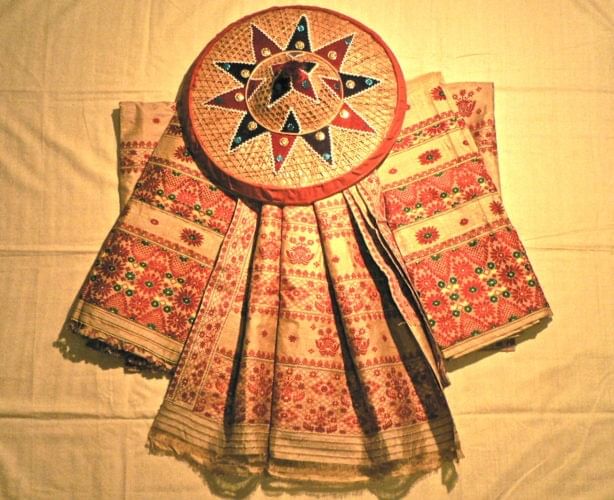 Silk in the Gupta Period
Silk in the Gupta Period- The manufacture of oil increased because of the use of the oil wheel.
- The inscriptions of the period mention weavers, goldsmiths, dyers, workers in metal and ivory, jewellers, sculptors, smiths, and perfumers as constructors of caves and donors of pillars, tablets, etc. to the Buddhist monks.
- Coin-minting was an important craft, and the period is noted for numerous types of coins made of gold, silver, copper, bronze, lead, and tin.
- The craftsman also made fake Roman coins. Various coin moulds belonging to the period have been found both in north India and in Deccan.
- A coin mould from the Satavahana level shows that through it half a dozen coins could be turned out at a time.
- These urban handicrafts were supplemented by the manufacture of beautiful pieces of terracotta, which are found in profuse qualities.
- Terracottas were meant mostly for use by the upper classes in towns. With the decline of town in Gupta, and especially in post-Gupta times, such terracottas almost went out of fashion.
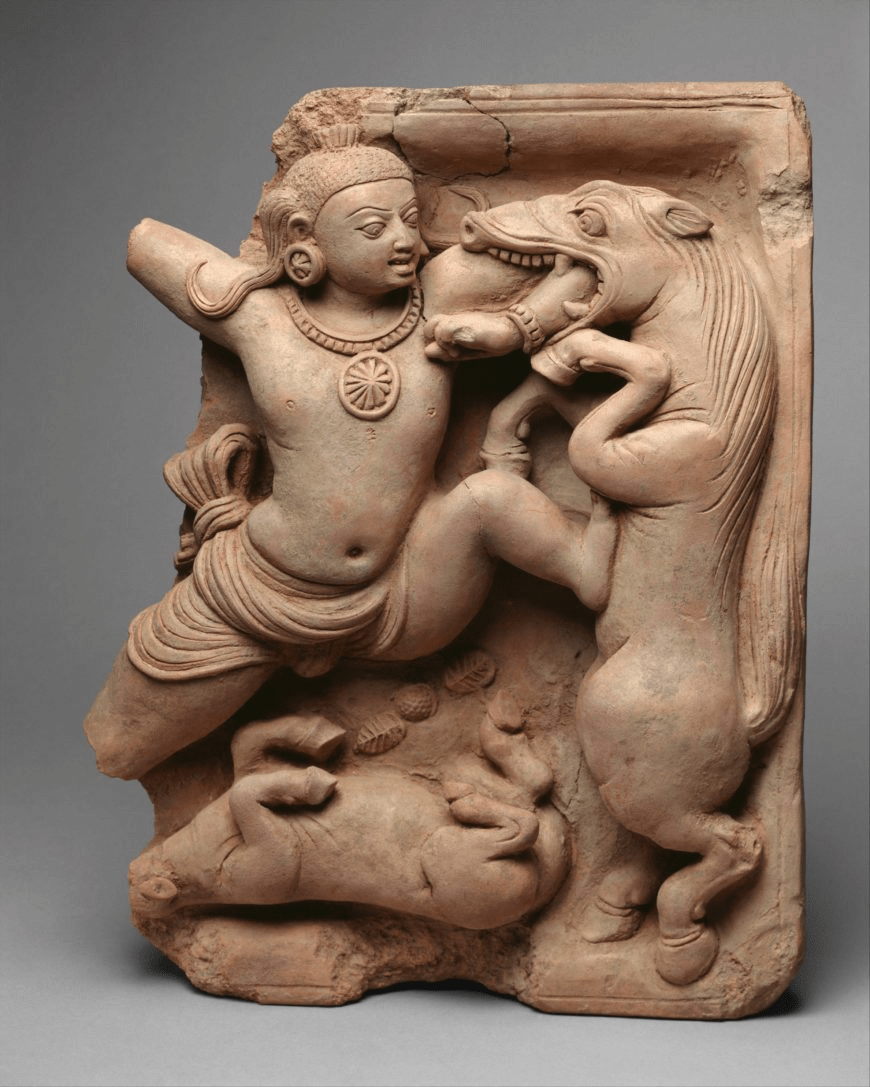 An Artefact of Terracotta during the Gupta Age
An Artefact of Terracotta during the Gupta Age- The Satavahana inscriptions show that there were in western India at that time guilds that acted as banks.
- One inscription states that an oil-pressers guild (Tailikanikaya) received two amounts of money
- Question for The Gupta Period: Trade, Art & Culture, Economic DevelopmentTry yourself:What was the main article of internal trade during the Gupta period?View Solution
Classification of Land
- In the Gupta period, land survey is evident from the Poona plates of Prabhavati Gupta.
- Kshetra: A special type of land capable of producing all kinds of crops.
- Khila: Land that has not been cultivated for three years.
- Aprahata: Defined as ‘unclaimed jungle land’.
- Vasti: Habitable land
- Gapatha Sarah: Pastoral land.
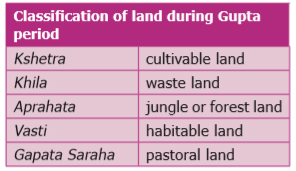
Land Tenure
- Bhumichhidranyaya: Rights of ownership are acquired by a man making barren land cultivable. It is free from tax.
- Aprada Dharma: Right to enjoy a property but no right to make a further gift.
- Nivi Dharma Aksayena: A perpetual endowment which a donee could not alienate but could make use of the income accruing from it eternally.
- Nivi Dharma: Land endowment in perpetuity.
- The huge sacrificial fees (dakshina) paid after the completion of various Vedic rites by Queen Naganika point to a high degree of economic prosperity which must have depended on maritime commerce.
- The type of Andhra coins with the figure of a shion the obverse and the account preserved in the Periplus of the Erythraean Sea, all testify to the maritime commerce of the day.
Economic Development Through Trade & Commerce
The most important economic development of the period was the thriving trade between India and the eastern Roman empire.
- In the beginning, a good deal of this trade was carried on by land, but the movement of the Sakas, Parthians and Kushans from the first century B.C. disrupted trade by land route.
- Although the Parthians of Iran imported iron and steel from India they presented great obstacles to India’s trade with the land further west of Iran.
- But from the first century, A.D. trade was carried on mainly by sea. It seems that around the beginning of the Christian era, the monsoons were discovered. So the sailors now could sail in much less time directly from the eastern coast of the Arabian Sea to its western coast.
- They could call easily the various parts such as Broach and Sopara situated on the western coast of India, and Arikamedu and Tamralipti situated on its eastern coast.
- Of all these ports Broach seems to have been the most important and flourishing.
- The Sakas and the Kushans used two routes from the north-western frontier to the western sea coast. Both these routes converged at Taxila and were connected with the Silk Route passing through central Asia.
- The first route directly ran from the north to the south connecting Taxila with the lower Indus basin from where it passed on to Broach. The second route, called the Uttarapatha, was in more frequent use.
- In the early centuries before and after the Christian era the Kushan Empire touched the fringes of the Roman Empire in the west and the ‘celestial empire’ in the east. Indians acted as the chief intermediaries in the silk trade, besides exporting muslin and spices.
- Their favourable balance of trade, which Pliny mentions, resulted in the creation of a gold standard in India.
- Wina Kadphises and his successors issued gold coins, which were in point of shape, size, weight, and material content exactly similar to Roman Solidus and Denarius.
- People on the Coromandel coast were engaged in trade with south-east Asia. The Jataka texts, the Niddesa, the Milinda Panho, the Kathasaritsagara and epigraphic evidence from south-east Asia, point to an increasing Indian mercantile enterprise and subsequent political domination in the region.
- The unrest caused by the extensive race movements from the 2nd century B.C. in Central Asia rendered the old silk route unsafe and the Chinese silk trade with the West was carried on through Indian intermediaries.
- According to the Periplus of the Erythraean Sea, Indian exports generally consisted of precious and semi-precious stones, (diamonds, pearls, sapphires, onyx sardonyx, agate, carnelian), ivory cotton cloth called Monakhe and Sagnatogene, muslin and mallow cloth, Chinese silk cloth, spices and medical products like pepper, ward, spikenard, costus, long pepper and malabathrum.
- The articles of import at the port of Barygaza included Italian and Arabian wines, copper, tin and lead, coral, topaz, flint glass, storax, antimony, gold and silver coins, singing boys, and beautiful maidens were also brought specially for the king.
Conditions caused by the wars with the Hunas and others
Chandragupta II was the first Gupta king who minted silver coins after defeating the Saka satraps of Ujjain. The barter system also existed side by side with currency.
- Industries as before were organized under guilds. The Vaisali seals refer to the guilds (naigama, sreni) of bankers (sresthis), traders (Sarthavaha) and artisans (kulika).
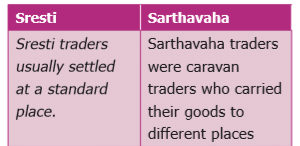 Guilds
Guilds- Specific mention has been made of the guild of oil pressers (tailika), silk weavers (pattavaya-sreni) etc. Each guild had a president called Prathawa or Pravana.
- Something like a modern chamber of commerce or cartel also existed. There are references to Sresthi-Kaulika-Nigama. These guilds undertook banking operations and accepted donations to be held in perpetuity (ajasrikam) on certain conditions which were registered (nibaddha).
- A guild of the town of Ajapuraka thus received a permanent endowment (aksayanivi).
- Banking operation was undertaken by temple committees as well, such as the Panchamandali of the Kakanidabota-mahavihara. The importance of the industrial and mercantile communities in the body politic can be seen in the advisory council of the District Magistrate (Visayapati).
- The guild had their property and trusts, settled disputes of their members, and issued their hundis and probably even coins.
- Some guilds even kept their soldiers which forced the Gupta rulers to frame certain laws to limit their powers.
- Prices in the Gupta period were not always stable and they also varied from place to place. Similarly, land measures, weights, and measures were also different at different places.
- The internal trade was carried on by roads and rivers and foreign trade was carried on by sea and land.
- We have numerous references to sea trade in the period, but the sea routes were not safe for the merchants. We learn from Fa-Hein that the Central Asian route from China to India was full of perils.
- Indian ports maintained regular maritime relations with Sri Lanka, Persia, Arabia, Ethiopia, the Byzantine Empire, China, and the islands of the Indian Ocean.
- India’s commercial relations with China also flourished and trade was conducted through the land and the sea routes.
- The volume of external trade between India with China greatly increased during the Gupta period. The Chinese silk, which was known as chinanshuka, had a good market in India.
- However, India’s trade with the West somewhat declined due to the decline of the Roman empire. However, it was revived again under the Byzantine emperors.
Conclusion
During the Gupta period, Indian ports maintained relations with Sri Lanka, Persia, Arabia, Ethiopia, the Byzantine Empire, China, and the Indian Ocean islands. Sri Lanka was an important port in both the island's foreign trade and inter-oceanic commerce between the East and the West. During the Gupta era, India's external trade with China increased significantly. Chinasunka, a Chinese silk, was popular in India.
To practice the questions of the topic "Gupta Period", you just read, attempt the tests given below:
|
216 videos|855 docs|219 tests
|
FAQs on The Gupta Period: Trade, Art & Culture, Economic Development - History for UPSC CSE
| 1. What was the significance of the Gupta Period in Indian history? |  |
| 2. Who were the prominent rulers of the Gupta Empire? |  |
| 3. How did trade and commerce flourish during the Gupta Period? |  |
| 4. What was the agrarian structure like during the Gupta Period? |  |
| 5. What were the major contributions to art and crafts during the Gupta Period? |  |

















